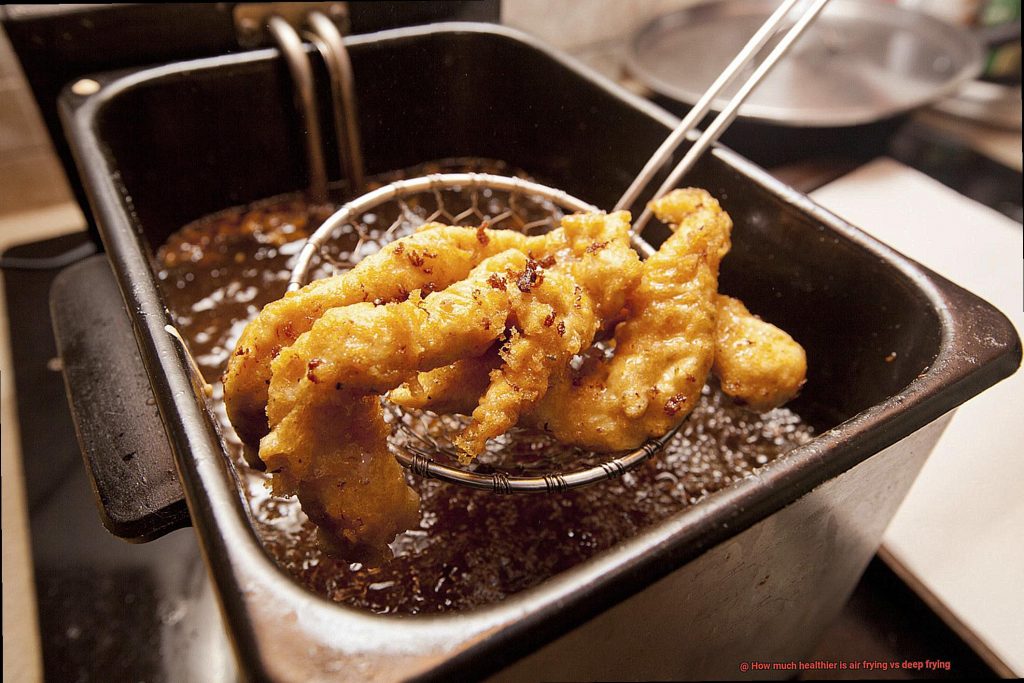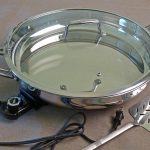Do you crave deep-fried food but hate the guilt that comes with it? Fear not, because air frying is here to save the day. In recent years, air frying has become a popular alternative to deep frying, promising healthier, low-fat meals without compromising on taste. But just how much healthier is air frying compared to deep frying?
Let’s start with the cooking process. Deep frying involves submerging food in hot oil, resulting in crispy and delicious food but also high in fat and calories. On the other hand, air frying uses hot air to cook food, eliminating or significantly reducing the need for oil while still achieving that same crispy texture. This makes it a healthier option as it significantly reduces fat content.
Moreover, air frying requires less cooking time than deep frying at high temperatures, which means fewer carcinogens are produced. This further cements air frying’s place as a healthier cooking method.
To sum up, air frying provides a much healthier alternative to deep-frying by eliminating/reducing oil usage and lowering fat content while still delivering scrumptious results. So why not give air-frying a try at your next meal? Your taste buds (and health) will thank you.
Contents
Overview of Deep Frying
Deep frying is a beloved cooking method that involves immersing food in hot oil to cook it quickly and thoroughly. Chicken, french fries, and fish are just a few of the many foods commonly deep-fried. While deep frying has its perks, such as producing crispy and delicious results, it can also have negative health effects due to the high levels of fat and calories in the oil used.
When food is deep-fried, it absorbs a significant amount of oil, which can lead to increased calorie consumption and weight gain. The high temperatures involved in deep frying can also cause harmful compounds to form in the oil, such as acrylamide and trans fats. These compounds have been linked to an increased risk of cancer and heart disease.
Despite these negative health effects, deep frying remains a popular cooking method due to its convenience and delicious results. However, alternatives are available for those who want to enjoy fried foods without the negative health effects. One such alternative is air frying.
Air frying uses minimal amounts of oil, usually one tablespoon or less, to cook food. This method works by circulating hot air around the food to create a crispy exterior while keeping the interior moist and tender. By using less oil, air frying reduces the amount of fat and calories in the food, making it a healthier option than deep frying.
Research has shown that air frying can reduce the amount of fat in food by up to 80% compared to deep frying. This is fantastic news for people who love fried foods but don’t want to consume excessive amounts of unhealthy fats and calories. Furthermore, air frying is safer than deep frying because it eliminates the risk of hot oil splatters and burns. It’s also more environmentally friendly because it produces less waste than deep frying.
While air frying is a healthier option than deep frying, not all foods are suitable for this cooking method. Foods that are already high in fat or have a high water content may not produce desirable results when air fried. It’s essential to experiment with different foods and recipes to determine which ones work best with this cooking method.
Overview of Air Frying

Air frying has become increasingly popular in recent years due to its many perceived health benefits. This cooking method involves circulating hot air around food, resulting in crispy and golden-brown dishes without the need for excessive amounts of oil.
One of the major benefits of air frying over deep frying is the ability to significantly reduce the amount of fat and calories in your meals. Deep frying requires submerging food in hot oil, which can absorb a significant amount of oil and result in higher calorie content. Air frying, on the other hand, uses little to no oil, resulting in lower calorie content and less fat. This makes air frying a great option for those who want to enjoy their favorite fried foods without compromising their health goals.
In addition to being a healthier cooking method, air frying also offers convenience. Traditional deep frying requires large amounts of oil and can be messy and time-consuming. On the other hand, air frying is quick and easy with minimal cleanup required. Simply add your food to the air fryer basket, set the temperature and time, and let the machine do the work.
While some may argue that air-fried food doesn’t taste as good as deep-fried food, this is not necessarily true. With the right recipe and seasoning, air-fried food can be just as flavorful and satisfying as its deep-fried counterpart. Plus, you won’t have to deal with the unpleasant aftertaste or greasy feeling that often comes with deep-fried food.
When it comes to using an air fryer, there are endless possibilities for dishes you can make. From crispy chicken wings to homemade potato chips, there are plenty of options for creating healthy yet delicious meals. Additionally, many air fryers come with accessories such as baking pans or skewers, making it even easier to create a variety of dishes.
Health Benefits of Air Frying vs Deep Frying
When it comes to health benefits, air frying is the better choice. Let’s take a closer look at why.
Deep frying involves submerging food in hot oil, resulting in excess oil absorption and a high calorie count. A single serving of deep-fried food can contain up to 700 calories and 40 grams of fat. This can lead to weight gain, heart disease, and other health problems. On the other hand, air frying uses hot air to cook food, which significantly reduces the amount of oil needed for cooking. This means that air fried foods contain fewer calories and less fat than deep-fried foods.
Air frying can reduce the calorie count by up to 70% compared to deep frying. Additionally, air frying is a healthier option because it does not expose food to the harmful compounds that can be produced by heating oil to high temperatures.
But the benefits of air frying don’t stop there. Air frying also allows for the retention of more nutrients in foods than deep frying. Deep frying destroys the nutrients in food due to the high temperatures used in cooking. This leads to a loss of vitamins and minerals. Air frying preserves the integrity of the food’s nutrients while still producing a delicious and crispy result.
In summary, choosing air frying over deep frying has numerous health benefits such as reducing calorie intake and fat consumption, retaining more nutrients in foods, and avoiding exposure to harmful compounds. It’s time to give air frying a try. Your taste buds and your body will thank you.
The Difference in Oil Used in Each Method
Not only does air frying reduce calorie intake by up to 70%, but it also preserves nutrients and avoids harmful compounds. But what’s the difference in oil used between air frying and deep frying, you ask? Let’s explore.
The type of oil used in cooking is crucial in determining the healthiness of a dish. Deep frying involves immersing food in a large amount of oil at high temperatures, resulting in an excessive amount of oil being absorbed by the food. This can lead to an increase in calories and unhealthy fats, such as trans fats.
Air frying, on the other hand, requires only a small amount of oil for that crispy exterior. Hot air is circulated around the food, eliminating the need for excessive oil. Additionally, most air fryers come with a drip tray that collects any excess oil that may be released during the cooking process, resulting in a much healthier and lower calorie version of your favorite fried foods.
When it comes to choosing the type of oil to use for air frying or deep frying, it’s important to opt for healthier options. Oils such as olive oil, avocado oil, and coconut oil are excellent choices for air frying due to their high smoke point and health benefits. For deep frying, peanut oil or canola oil are recommended due to their high smoke point.
How Air Frying Reduces Fat and Calories
Not only does air frying create a crispy outer layer, but it also significantly reduces the amount of fat and calories in your meals.
One of the main benefits of air frying is its ability to drastically cut down on the amount of oil needed. Unlike deep frying, which requires food to be immersed in hot oil, air frying only needs a small amount of oil to create that perfect crunch. In fact, it can reduce the amount of fat in your meal by up to 80%. This is achieved through the circulation of hot air around the food, cooking it evenly and creating that sought-after crispiness with minimal oil.
But that’s not all. Air frying also doesn’t require pre-heating or long cooking times, which further reduces the overall calorie count of your meal. This makes it a healthier alternative to traditional deep frying, allowing you to indulge in your favorite fried foods without compromising on taste or nutrition.
Another great benefit of air frying is that it helps to retain more nutrients in the food when compared to deep frying. High temperatures in deep frying can cause some nutrients to break down and be lost. Air frying, on the other hand, uses lower temperatures resulting in less nutrient loss and preserving the natural flavors and textures of your food.
Safety Considerations with Air Frying vs Deep Frying
Air frying may be the answer, but it’s important to consider safety when comparing it to traditional deep frying methods.
One of the most significant safety concerns with deep frying is the use of hot oil. This can easily spatter and cause serious burns or even start a fire if not handled properly. To prevent these hazards, it’s important to use a deep fryer with safety features like temperature control and a lid to prevent splattering.
In contrast, air frying requires no oil at all, eliminating the risk of burns or fires from hot oil. However, it’s still crucial to follow basic safety guidelines when using an air fryer. Overcrowding the basket can reduce proper airflow and lead to overheating. Always use oven mitts or tongs to safely handle food and the air fryer basket when it’s hot.
Another safety consideration is the risk of undercooked or overcooked food. Deep frying can make it difficult to determine doneness without cutting into the food or using a thermometer. This could potentially lead to food that is unsafe to eat or doesn’t taste as good as it could.
Air frying allows for more precise temperature control and cooking times, reducing the likelihood of undercooked or overcooked food. Most air fryers come with preset cooking times and temperatures for specific foods, making cooking less guesswork and more efficient.
Environmental Impact of Air Frying vs Deep Frying
If so, let’s talk about air frying and deep frying. While both methods can make deliciously crispy food, they have vastly different environmental impacts.
First, let’s consider deep frying. This method requires a large amount of oil, which not only generates waste but can also lead to oil spills and pollution. Disposing of used oil can be a challenge too, as improper disposal can harm aquatic life and clog pipes. It’s clear that deep frying has a significant negative impact on the environment.
Now let’s look at air frying. This method requires minimal oil, which means less waste and easier disposal of excess grease. Additionally, air fryers use less energy compared to deep fryers, resulting in lower carbon emissions and a smaller environmental impact. Plus, air frying doesn’t release harmful fumes or pollutants into the air during cooking, unlike deep fryers that can produce smoke and grease that contribute to air pollution.
In summary, air frying is the clear winner when it comes to environmental impact. Here are some reasons why:
- Uses less oil: Less waste generated and easier disposal of excess grease
- Less energy usage: Lower carbon emissions
- No harmful fumes or pollutants: Better for air quality
Foods Suitable for Air Fryers
Let’s start with the types of foods that can be air fried. Some of the most popular options include crispy chicken wings, perfectly golden French fries, flavorful vegetables, and even delicious desserts. Air frying uses hot air circulation to produce crispy and crunchy textures, making it great for cooking foods that are typically associated with deep frying.
Now, let’s talk about why air frying is a healthier alternative to deep frying. Deep frying involves submerging food in hot oil, resulting in high levels of fat and calories. However, air frying requires little to no oil, meaning you can enjoy your favorite fried foods with less guilt. Plus, air fryers can still produce crispy textures using hot air circulation instead of oil.
But not all foods are suitable for air frying. Foods that are naturally high in moisture, such as battered fish or doughnuts, may not cook evenly in an air fryer and could end up soggy. It’s also important to note that some foods may require a little bit of oil to achieve the desired texture and flavor.
So, what should you air fry? Here’s a list of some popular options: chicken tenders, sweet potato fries, onion rings, Brussels sprouts, mozzarella sticks, and even apple chips for a healthy dessert option.
KzDT4WRnxu0″ >
Conclusion
To sum up, air frying is a much healthier option compared to deep frying. By significantly reducing the amount of oil needed for cooking, air frying lowers fat content and calorie intake while still delivering that mouthwatering crispy texture we all crave. Furthermore, air frying requires less cooking time than deep frying at high temperatures, resulting in fewer harmful compounds being produced.
In addition to its health benefits, air frying offers many other advantages over deep frying. It’s convenient, easy to clean up after, and helps retain more nutrients in food. Safety is also a major factor to consider when deciding between these two methods – air frying eliminates the risk of hot oil splatters and burns.
When it comes down to choosing between air frying and deep frying, it’s important to weigh up safety concerns and environmental impact against which foods are suitable for each method.
While both techniques can produce deliciously crispy food, air frying is the clear winner when it comes to health benefits and environmental impact.






